
Memento Mori: 1 2 3 4 5 6 Next>>
Memento Mori in the Golden Age of Piracy, Page 4
Anatomy Books
Anatomy books would have been a key part of a surgeon's education during the golden age of piracy, just as they are today.
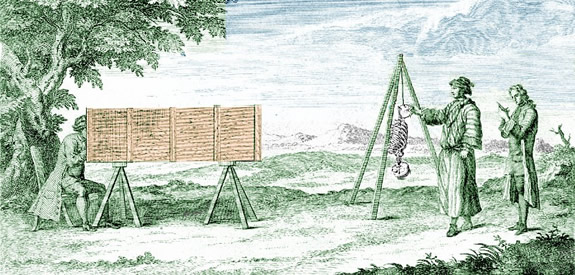
William Cheselden Drawing a Skeleton, Osteographia or the Anatomy of the bones, Title Page (1733)
Some of these anatomy book artists showed their skeletons in natural poses - leaning on things, praying, walking outdoors, thinking, weeping and even considering memento mori symbols. For this reason (and to tie this article loosely into the pirate surgeon motif), we will look at some of these book engravings and their authors.
Four writers in particular show skeletons in such situations, so we will focus on their work. They include Andreas Vesalius' De humani corporis fabrica of 1543, Govert Bidloo's Ontleding Des Menschelyken Lichaams from 1690, William Cheselden's Osteographia or The anatomy of the bones, first printed in 1733 and Bernhard Siegfried Albinus' Tabulae Sceleti et Musculorum Corporis Humani from 1749.
Anatomy Books: Andreas Vesalius, De humani corporis fabrica (1543)
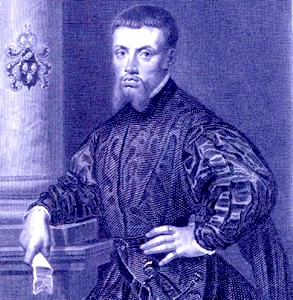
Anatomist Andreas Vesalius
Andreas Versalius was an anatomist and physician. He was born in Brabant, Belgium to a family of prominent physicians in the city of Wesel, Duchy of Cleves. He learned anatomy at the University of Padua where he would eventually teach the same topic. Vesalius wrote two important texts on anatomy: Tabulae sex (Six Plates, 1538) and De humani corporis fabrica (The Fabric of the Human Body, 1543).
His second book featured illustrations with some of the most accurate depictions of a human’s internal organs from the time. The illustrations were considered to be "of great artistic merit"1 which "came, in part, from using woodcuts, a process that allowed the greatest accuracy in reproduction."2
While Vesalius doubtless created many of the sketches3, it would have been extremely difficult for one person to create all 273 detailed illustrations in so short a time.4 In fact, the artwork in the book is usually attributed to the "Studio of Titian" rather than a single artist. (Titian being Tiziano Vecelli, a famous Italian painter in the late 15th century. There were be several other artists working out of his studio.)
Below are some of the renderings of skeletons from Vesalius' book. Note the amazing positioning of the bones in this illustrations. You will also find what could be memento mori touches in each of these drawings, although it is not clear whether this was intentional or simply just an artistic flourish.
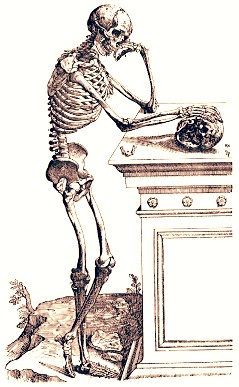 Skeleton Pondering Skull on Monument, from De humani corporis fabrica (1543) |
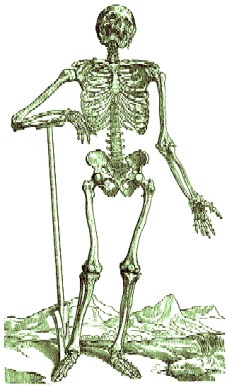 Skeleton Resting on Shovel, from De humani corporis fabrica (1543) |
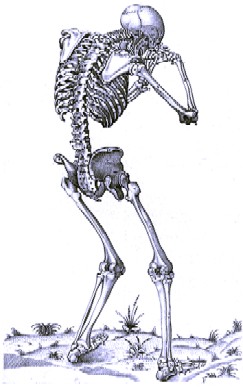 Skeleton Weeping, from De humani corporis fabrica (1543) |
1 "De humani corporis fabrica", wikipedia.com, gathered 10/12/14; 2 "Andreas Vesalius", umich.edu, gathered 10/12/14; 3 "Vesalius, Andreas. De corporis humani fabrica libri septem. (Basel: Johannes Oporinus, 1543)", Historical Anatomies on the Web, gathered 10/1/14; 4 "Andreas Vesalius", wikipedia.com, gathered 10/1/14
Anatomy Books: Govert Bidloo, Ontleding Des Menschelyken Lichaams (1690)
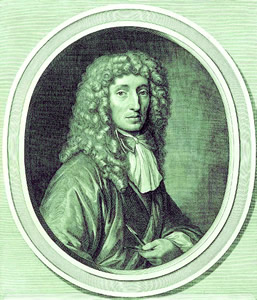
Anatomist Govard Bidloo
Govard Bidloo was born in Amsterdam to a pharmacist in 1649. He studied surgery as a student of the anatomist Frederik Ruysch in 1670. He went on to study medicine at the University of Franeker, Friesland (now the Netherlands) where he received his degree in 1682. He became a professor of anatomy at The Hague (Netherlands) in 1688, lecturing on anatomical dissection. He held this position until 1694, when Bidloo moved to Leiden University in the Netherlands to become a professor of anatomy. He held that position until 1713.
While at the Hague, Bidloo was appointed as the head of the national hospital service in 1690, a position he also held in England beginning in 1692. He was appointed the physician to William III of England in 1690 (William or 'Willem' originally being Dutch) in whose service he continued until the King's death in 1702.
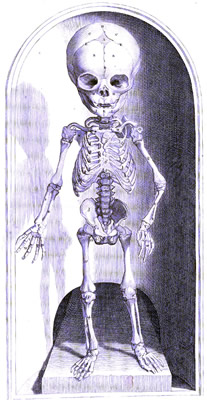
Child's Skeleton Ontleding Des
Menschelyken Lichaams,
Table 101 (1690)
In 1685 Bidloo published his anatomical atlas in Amsterdam, Anatomia Humani Corporis, which contained 107 copperplate engravings. He republished the book in Dutch in 1690 as Ontleding des menschelyken lichaams. "Like so many large and expensive anatomical atlases of the time, the work was not a financial success"1.
A fellow anatomist at the time, Anton Nuck described the book: "Mons. Bidloo, a skilful chirurgeon of Amsterdam, had newly shewed him above 100 anatomical figures of the parts of a man as big as the life, ingraven on copper, with a description of the parts, but not of their use."2 This failure to explain the function of the parts in his figures was noted by several critics at the time.
Bidloo's book was one of the first to describe fingerprints. "This was one of the pioneering scientific observations which laid the foundation of forensic identification using fingerprints."3 His images of the brain and nerves revealed great detail because of the size of the book, which made them useful to seventeenth–century researchers and physicians.4
Bidloo's book is actually the only one on this page published in the golden age of piracy. It is notable for its intentional inclusion of memento mori symbols. As explained previously, Memento Mori Art gained popularity throughout the 17th century, declining gradually starting in the 18th century, which might explain why it appears in Bidloo's book of skeletons. The pin-prick pupils seen in his full skeletons is most unsettling.
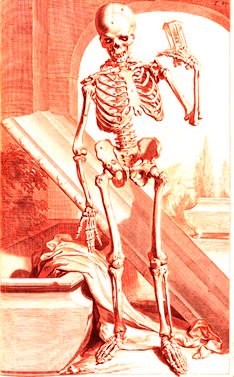 Skeleton with Coffin, Shroud & Hourglass, From Ontleding Des Menschelyken Lichaams, Table 87 (1690) |
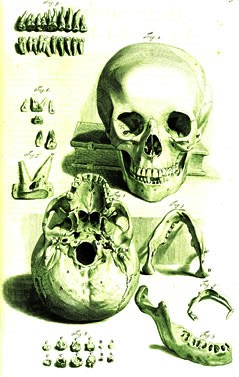 Detail of Skull On Book Showing Jaw and Teeth, From Ontleding Des Menschelyken Lichaams, Table 92 (1690) |
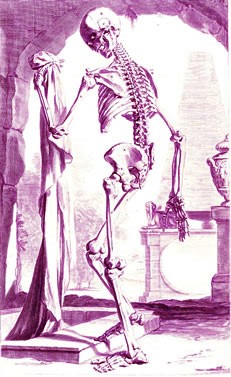 Skeleton Examining Shroud By Coffin & Urn, From Ontleding Des Menschelyken Lichaams, Table 88 (1690) |
1 "Bidloo, Govard. Ontleding des menschelyken lichaams.", Historical Anatomies on the Web, gathered 10/1/14; 2 "Govard Bidloo", Anatoma Animata, www.indiana.edu, gathered 10/12/14; 3 "Govert Bidloo", wkipedia.com, gathered 10/1/14; 4 "Govard Bidloo", Anatoma Animata, www.indiana.edu, gathered 10/12/14
Anatomy Books: William Cheselden, Osteographia or The anatomy of the bones, (1733)
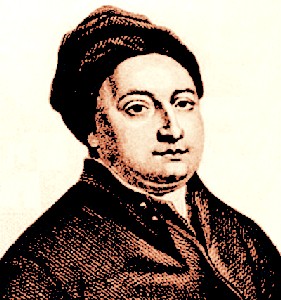
Anatomist William Cheselden
William Cheselden was born in 1688 at Somerby, near Burrow-on-the-Hill, Leicestershire. He was most likely apprenticed to a surgeon in Leicester in his early youth.1 By 1703 he was a student of noted anatomist William Cowper in London. He apprenticed as a surgeon at St. Thomas's Hospital in London around that time as well. In 1710 he was admitted to the London Company of Barber-Surgeons, passing the final examination in 1711. He was elected as a Fellow of the Royal Society in 1712.
Cheselden started lecturing on anatomy privately, eventually speaking on the topic at St. Thomas's. In 1718 he became a surgeon at the hospital, specializing in the removal of bladder stones. While there, he invented a new way to remove such stones, which "resulted in the increase in survival rates."2
His published his first book Anatomy of the humane body in 1713. It became an important textbook for physicians and surgeons, going through 16 English and American editions up to 1806.3
In 1733, his anatomy book Osteographia was published, "a grand folio edition depicting human and
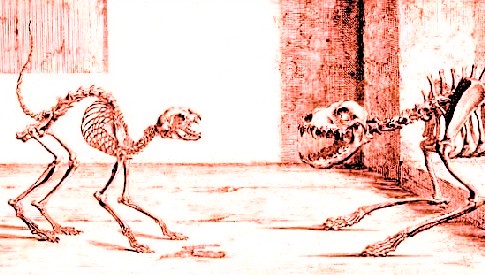
Dog and Cat Skeleton, Osteographia or The anatomy of the bones, Plate 25 (1733)
animal bones, featuring beautiful copperplate images, including playful skeletons, vignettes, and initials."4
Cheselden took an active role in preparing the book, choosing poses for the skeletons, overseeing the publishing process and correcting drawings where necessary. He commented that "the use of unhatched, single lines to evoke the smoothness of the ends of the bones 'was also my contriving'."5
Unfortunately, like Bidloo's Ontleding des menschelyken lichaams, the book was a financial failure.
Cheselden's book contains a large number of skeletons in natural poses. Among these are variety of animal skeletons. While these are not of primary interest in an article on memento mori, I can't resist including the one seen above, because of it's delightful positioning and inherent humor. Although Cheselden's human skeletons are interesting to look at, there is nothing to suggest a link to memento mori symbols in his artwork. Nevertheless, he created such interesting images that I have included many of them here.
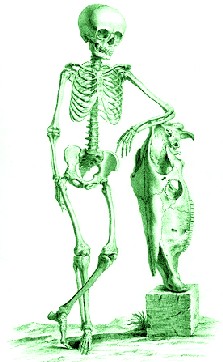 Adolescent Skeleton with Fish, Osteographia or The anatomy of the bones, Plate 33 (1733) |
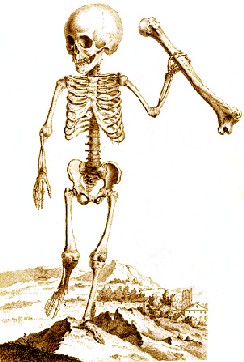 Child Skeleton Walking with Bone, Osteographia or The anatomy of the bones, Plate 32a (1733) |
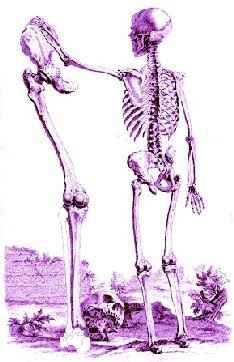 Adult Skeleton Leaning on Animal Bone, Osteographia or The anatomy of the bones, Plate 37 (1733) |
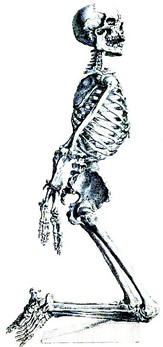 Skeleton Prisoner Kneeling, Osteographia or The anatomy of the bones, Plate 36 (1733) |
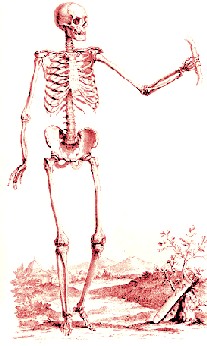 Adult Skeleton Holding a Bow, From Osteographia or The anatomy of the bones, Plate 35 (1733) |
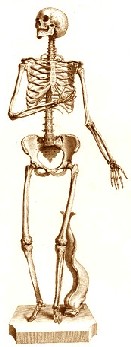 Skeleton Speaking, Osteographia or The anatomy of the bones, Plate 34 (1733) |
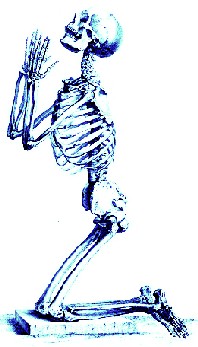 Adult Skeleton Kneeling in Prayer, From Osteographia or The anatomy of the bones, Plate 36 (1733) |
1 "Cheselden, William. Osteographia, or The anatomy of the bones.", Historical Anatomies on the Web, gathered 10/1/14; 2 "Govert Bidloo", wkipedia.com, gathered 10/1/14; 3,4 "Cheselden, William. Osteographia, or The anatomy of the bones.", Historical Anatomies on the Web, gathered 10/1/14; 5 Monique Kornell, "Accuracy and Elegance in Cheselden’s Osteographia (1733)". Public Domain Review, gathered 10/12/14;
Anatomy Books: Bernhard Siegfried Albinus. Tabulae Sceleti et Musculorum Corporis Humani (1749)
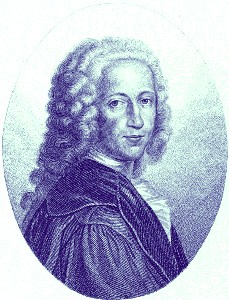
Anatomist Bernard Siegfried Albinus
Bernard Siegfried Albinus was born in 1697 at Frankfurt an der Oder, in Brandenburg, Germany. His father was a professor of surgery, who moved when Bernard was 5 to be the chair of medicine at Leiden University in the Netherlands.
Bernard began studying anatomy and medicine at the age of 12 under teachers such as the famous Dutch physician and botanist Herman Boerhaave. After completing his studies, Albinus went to Paris in 1718 to specialize in the study of anatomy and botany. He was recalled to Leiden by Boerhaave the next year to lecture on anatomy and surgery, eventually becoming a professor at the university two years later. He "speedily became one of the most famous teachers of anatomy in Europe, his classroom being resorted to not only by students but by many practising physicians."1
Albinus published Tabulae sceleti et musculorum corporis humani in Leiden in 1747, mostly at his own expense. He worked with artist Jan Wandelaar, who added "whimsical backgrounds" to many of the anatomies. The book "was highly criticized by such engravers as Petrus Camper" because of the backgrounds. Even so, Albinus stood behind Wandelaar's work, defending it from the critics.2
Albinus explained that he used a tripod and cords which he passed through the spine, arms, and legs of his skeletons to position them. The cords were then attached to his walls and ceiling. Bidloo adjusted their positions with wood and paper. He explains how he checked his poses by finding " a thin man, of the same size with my skeleton, and making him stand naked in the same position, [after which] I compared the skeleton with him."3 Albinus used grids to make "the perspective and proportion of the human body more accurate" by viewing the skeleton through nets. This was clearly a challenging thing to do, because Albinus noted that other anatomy artists "will find it no easy task neither, who engages in an affair of the same kind."4
Albinus' skeletons are posed naturally, walking and pointing. Perhaps the most interesting thing about them is the much-criticized backgrounds. They feature natural settings, including some potential memento mori symbology such as monuments, a tomb, winged cherubs and cloth, possibly representing a shroud.
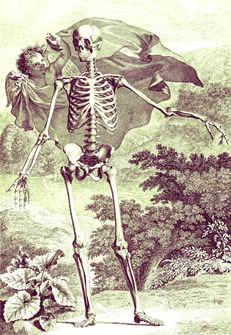 Skeleton Covered by Cherub in Forest, Table 1, Tabulae Sceleti et Musculorum Corporis Humani (1749) |
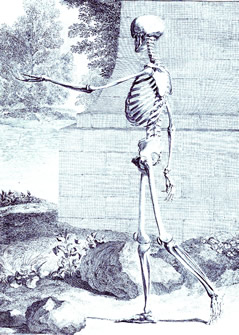 Skeleton Walking in Front of Monument, Table 3, Tabulae Sceleti et Musculorum Corporis Humani (1749) |
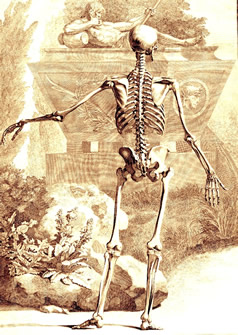 Skeleton Facing a Tomb,Table 2, Tabulae Sceleti et Musculorum Corporis Humani (1749) |
1 "Bernhard Siegfried Albinus", Wikipedia.com, gathered 10/1/14; 2 "Albinus, Bernhard Siegfried. Tabulae sceleti et musculorum corporis humani.", Historical Anatomies on the Web, www.nlm.nih.gov, gathered 10/1/14; 3,4 "Bernhard Siegfried Albinus (1697-1770)", exhibits.hsl.virginia.edu, gathered 10/12/14

